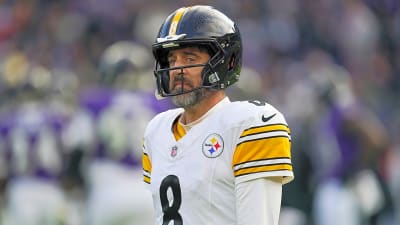- Home
- Quizzes
- My Quiz Activity
- Newsletters
- MY FAVORITES
- Add Sports/Teams
- SPORTS
-
NFL
- NFL Home
- Arizona Cardinals
- Atlanta Falcons
- Baltimore Ravens
- Buffalo Bills
- Carolina Panthers
- Chicago Bears
- Cincinnati Bengals
- Cleveland Browns
- Dallas Cowboys
- Denver Broncos
- Detroit Lions
- Green Bay Packers
- Houston Texans
- Indianapolis Colts
- Jacksonville Jaguars
- Kansas City Chiefs
- Las Vegas Raiders
- Los Angeles Chargers
- Los Angeles Rams
- Miami Dolphins
- Minnesota Vikings
- New England Patriots
- New Orleans Saints
- New York Jets
- New York Giants
- Philadelphia Eagles
- Pittsburgh Steelers
- San Francisco 49ers
- Seattle Seahawks
- Tampa Bay Buccaneers
- Tennessee Titans
- Washington Commanders
-
MLB
- MLB Home
- Athletics
- Arizona Diamondbacks
- Atlanta Braves
- Baltimore Orioles
- Boston Red Sox
- Chicago White Sox
- Chicago Cubs
- Cincinnati Reds
- Cleveland Guardians
- Colorado Rockies
- Detroit Tigers
- Houston Astros
- Kansas City Royals
- Los Angeles Angels
- Los Angeles Dodgers
- Miami Marlins
- Milwaukee Brewers
- Minnesota Twins
- New York Yankees
- New York Mets
- Philadelphia Phillies
- Pittsburgh Pirates
- San Diego Padres
- San Francisco Giants
- Seattle Mariners
- St. Louis Cardinals
- Tampa Bay Rays
- Texas Rangers
- Toronto Blue Jays
- Washington Nationals
-
NBA
- NBA Home
- Atlanta Hawks
- Boston Celtics
- Brooklyn Nets
- Charlotte Hornets
- Chicago Bulls
- Cleveland Cavaliers
- Dallas Mavericks
- Denver Nuggets
- Detroit Pistons
- Golden State Warriors
- Houston Rockets
- Indiana Pacers
- Los Angeles Clippers
- Los Angeles Lakers
- Memphis Grizzlies
- Miami Heat
- Milwaukee Bucks
- Minnesota Timberwolves
- New Orleans Pelicans
- New York Knicks
- Oklahoma City Thunder
- Orlando Magic
- Philadelphia 76ers
- Phoenix Suns
- Portland Trail Blazers
- Sacramento Kings
- San Antonio Spurs
- Toronto Raptors
- Utah Jazz
- Washington Wizards
-
NHL
- NHL Home
- Anaheim Ducks
- Boston Bruins
- Buffalo Sabres
- Calgary Flames
- Carolina Hurricanes
- Chicago Blackhawks
- Colorado Avalanche
- Columbus Blue Jackets
- Dallas Stars
- Detroit Red Wings
- Edmonton Oilers
- Florida Panthers
- Los Angeles Kings
- Minnesota Wild
- Montreal Canadiens
- Nashville Predators
- New Jersey Devils
- New York Islanders
- New York Rangers
- Ottawa Senators
- Philadelphia Flyers
- Pittsburgh Penguins
- San Jose Sharks
- Seattle Kraken
- St. Louis Blues
- Tampa Bay Lightning
- Toronto Maple Leafs
- Utah Mammoth
- Vancouver Canucks
- Vegas Golden Knights
- Washington Capitals
- Winnipeg Jets
- NCAAF
- NCAAM
- Olympics
- Boxing
- Entertainment
- Lifestyle
- Golf
- MMA
- Soccer
- Tennis
- Wrestling
- Sports Betting
- More Sports
- RESOURCES
- My Account
- YB on Facebook
- YB on Twitter
- YB on Flipboard
- Contact Us
- Privacy Policy
- Terms of Service
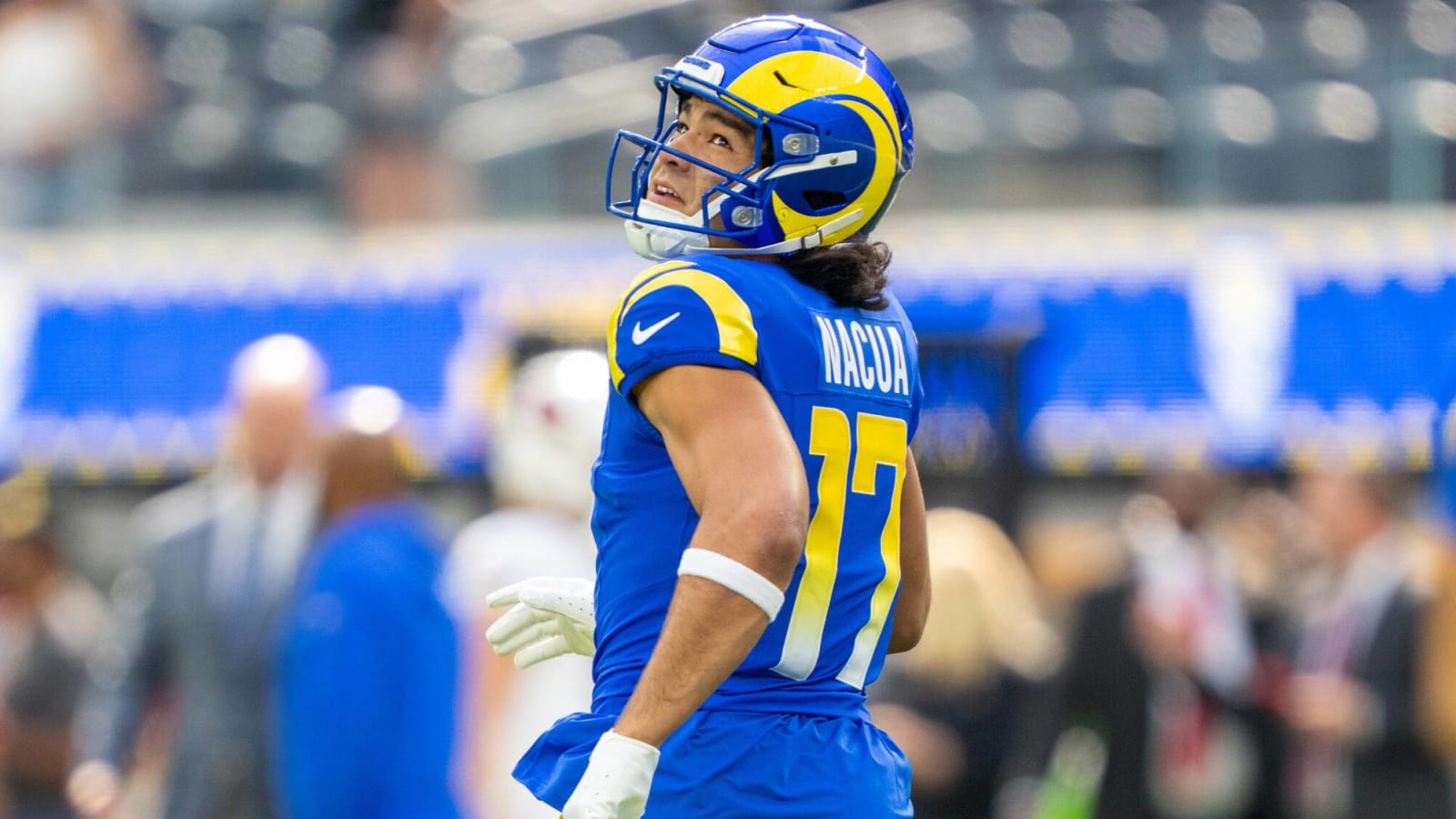
NFL wideouts from many eras have put together impactful rookie seasons. Here are the best first-year receiving performances in league history.
Bill Brooks, 1986
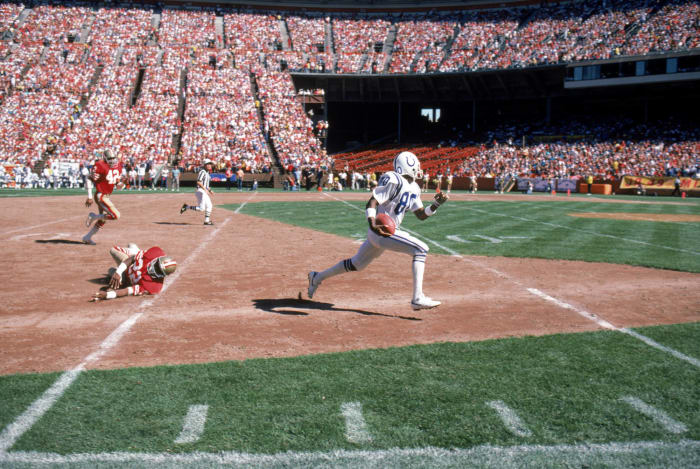
While these Colts' 0-13 start allowed for more passing opportunities, Brooks reaching 1,131 yards as a rookie came with a fellow rookie at quarterback. A Gary Hogeboom injury led to second-round pick Jack Trudeau entering the fray. Trudeau completed less than 49% of his passes, but Brooks scored eight touchdowns and was eighth in yardage that season. This began a lengthy stay as the team's top wide receiver. Part of this season's appeal: Brooks' rookie-year yardage total survived Andre Rison, Marvin Harrison, Reggie Wayne, and T.Y. Hilton debuts to remain a Colts rookie record.
Jerry Butler, 1979
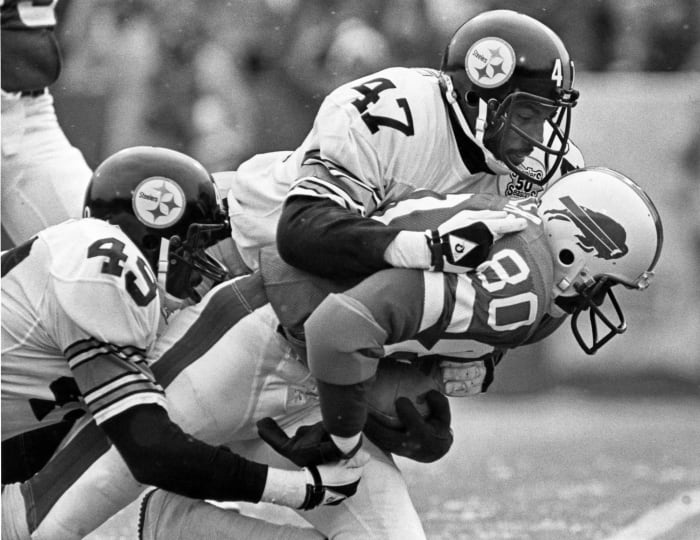
It is unfair to label Butler a one-hit wonder, but even if that were an appropriate classification, the hit remains astonishing. Chosen fifth overall, Butler became an instant starter. In Week 4, the Bills prospect set a rookie record that stood for 42 years. The Bills erased an 11-point deficit to beat the Jets 46-31, doing so on the strength of Butler's 10-catch, 255-yard, four-touchdown day. The long-striding wideout packed 74- and 75-yard TDs into his record yardage day, which did not exactly come in a high-octane era (unlike Ja'Marr Chase's 2021 record-breaker). Butler missed three games as a rookie but still got to 834 yards (17.4 per catch).
Don Looney, 1940

This list does not include many bad-team/high-yardage players, but a rookie shattered the NFL's reception record in 1940. Teaming with his TCU college quarterback (Heisman winner Davey O'Brien), Looney caught a then-record 58 passes -- breaking Don Hutson's previous record by 13. The Eagles finished 1-10 and threw at a high rate. Still, Looney led the NFL in receiving yards (707), beating out Hutson, who retired as that era's most dominant end. In a December game against Washington, the Eagles attempted an astounding 60 passes. Looney caught an NFL-record 14 of those. That was an Eagles single-game standard until 2014.
Eddie Brown, 1985

One of the few notable accolades to elude Jerry Rice: Offensive Rookie of the Year. Brown captured that. While the Bengals and Jets did not make out as well as the 49ers did in the 1985 first round, Brown and Al Toon became solid pros . The second wideout taken that year (behind Toon) beat both to the punch, becoming an instant weapon for Boomer Esiason. The deep threat totaled 942 yards (17.8 per catch) and eight touchdowns for a developing Bengals team. Brown played the No. 2 role behind Cris Collinsworth but soon switched up that hierarchy, later serving as the 1988 AFC champion Bengals' top weapon.
A.J. Green, 2011
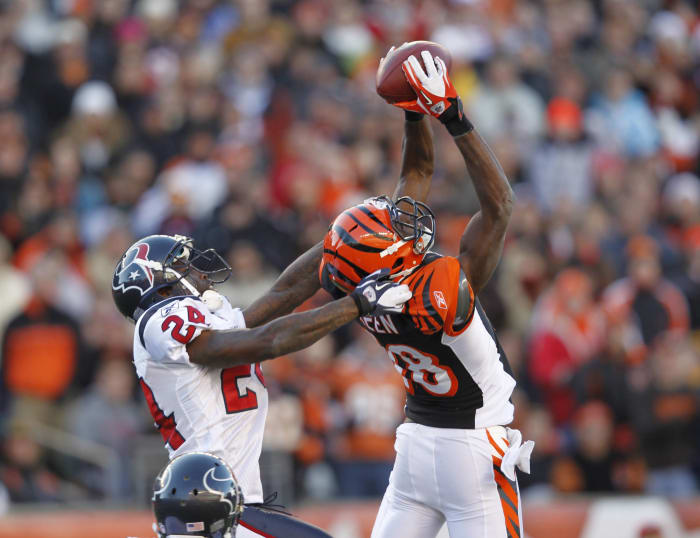
Green joined a team in transition, one that dismantled its 2010 aerial nucleus -- Carson Palmer, Chad Johnson, and Terrell Owens -- after a 4-12 season. The No. 4 overall pick teamed with rookie Andy Dalton, became Cincinnati's top weapon and was essential in the Bengals snapping a six-year playoff drought. Chosen two spots before Julio Jones, the polished Georgia prospect caught 65 passes for 1,057 yards and seven TDs. Green was the top variable in the Bengals offense staying viable amid Palmer's holdout/quasi-retirement. Green is the only wideout in NFL history to start his career with seven Pro Bowls.
Julio Jones, 2011

Jones entered the NFL after suffering a broken foot before that year's scouting combine. He then missed three games because of injuries to each hamstring. The Falcons still saw superstar potential throughout this season, with the No. 6 overall pick amassing 959 yards (a career-high 17.8 per catch) and eight TDs playing alongside Tony Gonzalez and Roddy White. Atlanta traded a bounty to move up 17 spots for Jones, but the rookie quickly became White's WR1 heir apparent. The burgeoning size-speed monster went on to make the most convincing claim to being the best player in Falcons history.
Joey Galloway, 1995

A speed merchant who went on to play 16 seasons, Galloway delivered quickly for a Seahawks team in need of young weaponry. The Seahawks teamed Galloway with struggling quarterback Rick Mirer, but the Ohio State-produced wideout still was a triple-threat dynamo in Year 1. Galloway reached 1,039 receiving yards, added 154 more on gadget handoffs, and posted a punt-return score. The heir apparent to Brian Blades in Seattle, Galloway helped the team to .500 for the first time in five seasons. He played five Seahawks seasons before a holdout gave way to a blockbuster trade to the Cowboys.
Keenan Allen, 2013

Philip Rivers earned a strange Comeback Player of the Year honor, collecting the honor despite not suffering an injury in 2012. Although Mike McCoy excelled in his first season as Chargers head coach, Allen was the on-field variable here. Just a third-round pick, the Cal product displayed his elite space-creating chops as a rookie by surpassing 1,000 yards (1,046) in 15 games. Known more for consistency than yards per catch, Allen reached a career-best 14.7 per grab as a rookie. And, after longtime rival (and later teammate) Chris Harris went down in the Bolts' divisional-round game, Allen put a scare into the AFC champion Broncos with 142 yards and two TDs.
A.J. Brown, 2019

The second-round Ole Miss product flashed eye-popping talent by posting 20.2 yards per reception, quickly usurping former top-five pick Corey Davis as the Titans' top target. A demon after the catch, Brown reached 1,051 yards on just 84 targets. The 226-pound matchup problem averaged 8.8 yards after catch per reception, leading the NFL in that Next Gen Stats metric. Derrick Henry powered Tennessee to that year's AFC championship game, but Brown teamed with Ryan Tannehill to help revive a scuffling team midseason. Four of Brown's five 100-yard games came in the season's final six weeks. Amazingly, this partnership lasted just three seasons.
Marques Colston, 2006

The Saints' 2006 offseason stands as one of the best in NFL history. Though the Drew Brees and Sean Payton arrivals represent the signature moments from it, a seventh-round pick became a linchpin for the Payton-Brees offenses that set various NFL records. The Saints chose Colton 252nd overall -- four away from Mr. Irrelevant status -- out of Hofstra. He immediately succeeded Joe Horn as New Orleans' No. 1 receiver, hauling in 70 passes for 1,038 yards and eight touchdowns in just 14 games. The big-bodied target helped the Saints go from 3-13 in 2005 to the NFC championship game in their post-Hurricane Katrina season.
Cris Collinsworth, 1981

Known more for pregame slides and an intense affinity for line play, Collinsworth was one of the better receivers of the 1980s. He broke through early to help the Bengals to Super Bowl XVI. Selected for the Pro Bowl in each of his first three seasons, Collinsworth jumped right in for a 1,009-yard showing as a rookie. The second-round pick scored eight touchdowns, showing the ability to get deep on established cornerbacks. Collinsworth led the Bengals in receiving during Ken Anderson's MVP season and eclipsed 100 yards in the Super Bowl. Though he also fumbled in that game, the future analyst did plenty to ignite the Bengals in 1981.
Terry Glenn, 1996

A top-10 pick out of Ohio State a year after Galloway, Glenn joined a better team and made a difference in it making a surprise Super Bowl run. Glenn caught 90 passes, which set a rookie record. While that has since been broken, as the NFL keeps gravitating toward an aerial game, Glenn outshined prized Jets rookie Keyshawn Johnson in 1996. The polished pass catcher was consistent throughout his rookie slate, going for 1,132 yards and nearly 200 more in the playoffs. Glenn was far and away the Pats' top target in '96, and he played a central role in the Drew Bledsoe-led squad reaching Super Bowl XXXI.
Sammy White, 1976

Debuting just before rule changes opened up the passing game, White still shined in a Pro Bowl season to help the Vikings to their fourth Super Bowl. A second-round pick out of Grambling, White tallied 906 receiving yards -- fifth in the NFL in 1976 -- and added 10 touchdown grabs in Fran Tarkenton's age-36 season. This included a 210-yard game against the Lions. White then became a central concern for Washington in the playoffs, adding two more TD catches in a Vikings first-round win. Jack Tatum's vicious hit on White in Super Bowl XI did not dislodge the ball, and the prized rookie scored another touchdown in that game.
Isaac Curtis, 1973

Ja'Marr Chase's stampede is not new for a franchise that has seen a few rookie wideouts become quick studies. Curtis was the first. Blessed with world-class speed, Curtis became such a problem for defenses that they took to double-teams and old-school physicality to slow him. Despite grabby corners' presences in a run-oriented era, Curtis caught 45 passes for 873 yards and scored nine TDs en route to the Pro Bowl. He helped the Bengals edge the burgeoning Steelers dynasty for the AFC Central title. Defenders' tactics this season, particularly in a playoff loss to the Dolphins, led to 1974's "Isaac Curtis Rule" -- a precursor to 1978's major changes.
Puka Nacua, 2023

With Cooper Kupp slowed by a hamstring injury to start the season, Nacua picked up the slack to help the Rams reload quickly. Chosen 177th overall, the BYU product was ready immediately. He strung together three 110-yard games in his first four outings. Kupp's return slowed Nacua's preposterous pace, but he has been vital to the Rams' surprise wild-card journey. Yes, this came in a 17-game season and involved an easier environment for aerial compiling. But Nacua finished the regular season with 105 catches, 1,486 yards and six touchdowns. This broke Bill Groman's 63-year-old record for receiving yards by a rookie.
Anquan Boldin, 2003

Boldin saw a ghastly 4.71-second 40-yard dash time help drop him to the second round. The Florida State product made that fall look foolish in his first game. Boldin's 10-catch, 217-yard, two-touchdown debut against the Lions alerted the NFL the Cardinals acquired a steal. One of the most physically imposing receivers in NFL annals, Boldin began with the Cards after Jake Plummer's free agency exit but still soared to Offensive Rookie of the Year acclaim. A year before Larry Fitzgerald's arrival, Boldin added four more 100-yard games and finished with a then-rookie-record 1,377 yards. That remains third for NFL rookies.
Harlon Hill, 1954
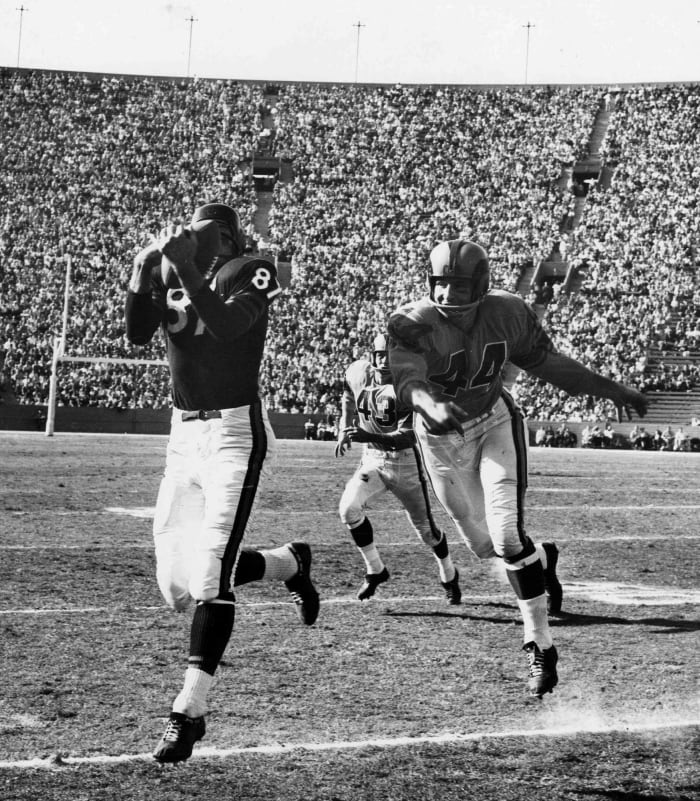
Hill's season came up regarding Ja'Marr Chase, whose first two NFL months required examinations into the former Bears receiver's prolific start. A 15th-round pick out of a Division II school, Hill dominated as a rookie by catching an NFL-best 12 touchdown passes and averaging a league-high 25 yards per reception. Hill missed a game but still totaled 1,124 receiving yards in 11 contests. His masterpiece came in a 214-yard, four-touchdown game against the 49ers. Hill's 66-yard grab was the game-winner in a back-and-forth contest, helping him to the first of three straight Pro Bowls.
Paul Warfield, 1964

Warfield played with the likes of Jim Brown and Larry Csonka, and the era in which he starred limited his stats. But Warfield is one of the best to ever play the position. A first-round pick out of Ohio State, the future Hall of Famer jumped in to lead the Browns in receiving (52 catches, 920 yards, nine TDs) and play a central role in the franchise's most recent championship season. The sleek deep target teamed with Frank Ryan, filling a void in Cleveland's passing game -- which featured no other player eclipse 600 receiving yards. Warfield and Brown represent one of the best running back-wideout duos in NFL history.
Justin Jefferson, 2020

The Vikings and Bills combined on one of the best win-win trades in modern NFL history. Jefferson and Stefon Diggs combined for 2,935 yards in 2020, but Diggs' replacement getting to 1,400 was more impressive. Obtained with the first-round pick acquired in the Diggs trade, Jefferson completed a rapid ascent after a slow start. The LSU slot dynamo fared well as an outside target in Gary Kubiak's offense, scoring seven touchdowns and replacing Diggs as Kirk Cousins' top target. The fourth wideout chosen in a stacked receiver draft, Jefferson narrowly missed Offensive Rookie of the Year honors.
John Jefferson, 1978
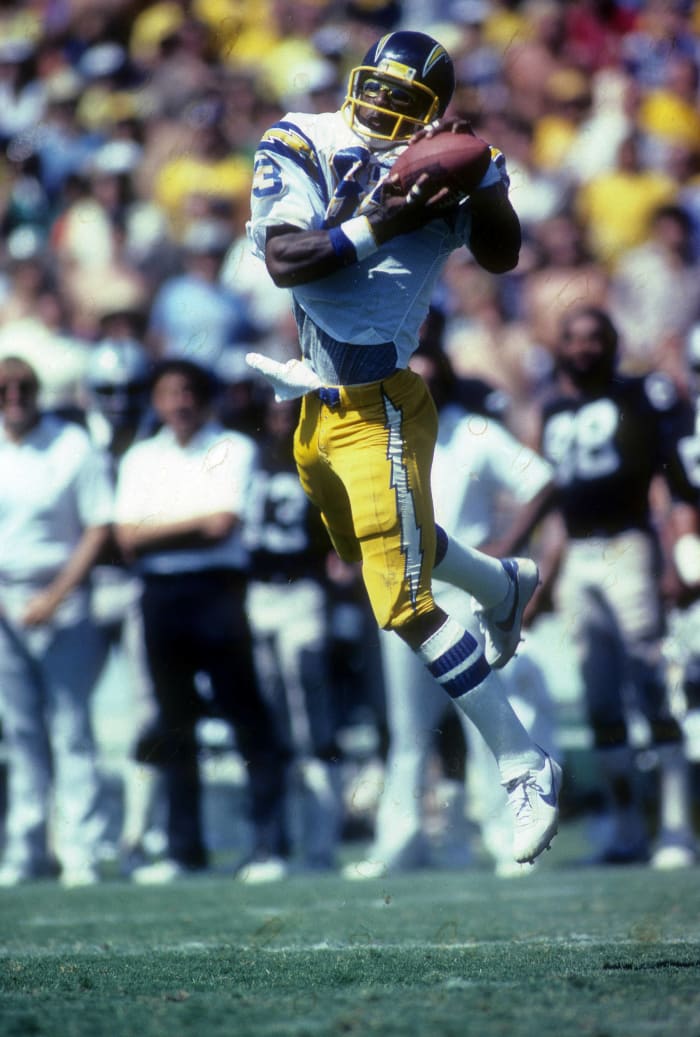
Few players enjoyed more fortunate timing upon coming into the NFL. Not only did Jefferson arrive in 1978, when the NFL finally implemented rules to unshackle pass catchers, but he joined a Chargers team on the cusp of deploying one of the league's great aerial attacks. Jefferson became the centerpiece of the Bolts' Air Coryell offense, going off for 1,007 yards and an NFL-high 13 touchdown catches. While Charlie Joiner made the Hall of Fame, his acrobatic apprentice was the player defenses feared most. Don Coryell's unusual midseason arrival catalyzed Jefferson, who became probably the NFL's best receiver over the next three seasons.
Bob Hayes, 1965

Many track sensations have tried their hand in the NFL; Hayes lapped that field. The 100-meter gold medalist at the 1964 Tokyo Games, Hayes provided a dimension-altering presence just as the Cowboys were on the cusp of their 20-year run of excellence. The unrivaled deep threat out of Florida A&M zoomed to 1,003 yards (21.8 per catch) and caught an NFL-most 12 TD passes. Teaming with QB Don Meredith, Hayes adjusted Cowboys games' geometry. While the 1965 Cowboys only went 7-7, the future Hall of Famer was vital to the first wave of Dallas teams that ventured to NFL title games and Super Bowls. (The Cowboys tried this again by drafting Carl Lewis in 1984, but lightning didn't strike twice.)
Billy Howton, 1952

The Packers went through a lull in the 1950s, limiting the NFL Films exposure for this stunning season. While Howton did not last through the Vince Lombardi era, it took more than 30 years for any Packer to equal the yardage total he produced at age 22. The second-round pick out of Rice led the NFL with 1,231 yards and added 13 receiving scores for the 6-6 Packers. This total was the second-best mark in NFL history at this point in time, behind only future Hall of Famer Elroy Hirsch. While other rookies have topped this yardage figure, Howton doing all this in just 12 games enhances his introduction's stature.
Ja'Marr Chase, 2021

The Bengals' shirked a bigger need by taking Chase over tackle Penei Sewell in the 2021 first round. Chase becoming one of the biggest rookie-year difference-makers for a Super Bowl team allowed the Bengals an emphatic draft victory. Their seminal decision to reunite Chase and ex-LSU cyborg Joe Burrow paid off, turning Cincinnati's skill corps from good to elite. Chase was streaky as a rookie but produced scary dominance -- highlighted by his rookie-record 266-yard detonation against the Chiefs -- to top a lofty list of scorching Bengals receiver debuts. Chase dropped 1,455 yards and 13 TDs before adding 389 playoff yards, nearly helping a downtrodden team win it all.
Bill Groman, 1960

It took 63 years for a player to top Groman's rookie-year yardage total. Despite coming out of a Division III school, Groman led all AFL or NFL receivers by more than 150 yards as a rookie by compiling 1,473 for the Oilers. He did this in 14 games. Groman and future record-setter Charley Hennigan provided George Blanda with a dynamic receiving tandem, one that powered Houston to the AFL's first championship. Groman had more 100-yard games (nine) than non-100-yard outings and totaled 12 TD catches, adding a 13th in the AFL's first championship game.
Odell Beckham Jr., 2014

Beckham's preposterous catch against the Cowboys accelerated his vault to stardom, but the ex-Giants superstar lit up the NFL throughout his abbreviated rookie year. Bouts of hamstring trouble kept Beckham off the field until Week 5. Once available, OBJ dazzled during one of the great breakouts in NFL history. The shifty playmaker did not surpass 50 yards in any of his first three games, making his 1,305-yard season all the more difficult. Beckham led the NFL with a rookie-record 108.8 yards per game. Although his storied catch against the Cowboys is the lasting image, Beckham scored 11 more TDs and instantly became the Giants' centerpiece player.
Randy Moss, 1998

The gulf between Moss and the field remains wide. Probably the greatest talent to play the position, Moss combined statistical dominance with instant impact. The all-time great made the biggest difference in turning the Vikings from a 9-7 squad to a 15-1 outfit that set the NFL's single-season scoring record. Moss only produced four 100-yard games -- peaking with the legendary 3-163-3 Thanksgiving showcase in Dallas -- in a 1,313-yard season, but the Marshall alum caught a rookie-record (and league-leading) 17 TD passes and added two more in the playoffs. Rewarding the Vikings after they stopped his draft slide, Moss became perhaps the toughest coverage assignment in NFL history and moved Hall of Famer Cris Carter to WR2 status.
Sam Robinson is a sportswriter from Kansas City, Missouri. He primarily covers the NFL for Yardbarker. Moving from wildly injury-prone sprinter in the aughts to reporter in the 2010s, Sam set up camp in three time zones covering everything from high school water polo to Division II national championship games
More must-reads:
- The best wide receiver draft classes of all time
- The best 'little guys' in NFL history
- The 'Oldest 4,000-passing-yard seasons' quiz
Breaking News
Trending News
Customize Your Newsletter
 +
+
Get the latest news and rumors, customized to your favorite sports and teams. Emailed daily. Always free!
PRIVACY POLICY EDITORIAL POLICY CONTACT US
ABOUT YARDBARKER TERMS OF SERVICE
Use of this website (including any and all parts and
components) constitutes your acceptance of these
Terms of Service and Privacy Policy.
This site is for entertainment purposes only.
There is no gambling offered on this site.
Gambling Problem? Call 1-800-Gambler.




